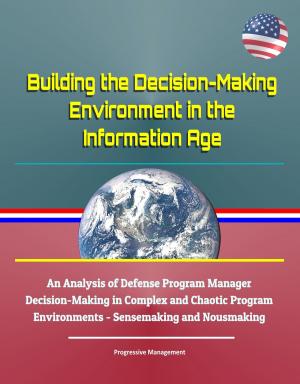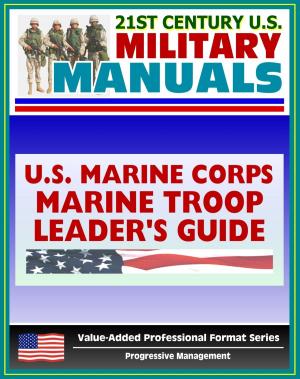Biological Incident Operations: A Guide for Law Enforcement - Terrorism Response, Protection, Intelligence, Investigation, Incidents, Personal Protection
Nonfiction, Social & Cultural Studies, Political Science| Author: | Progressive Management | ISBN: | 9781301842407 |
| Publisher: | Progressive Management | Publication: | April 27, 2013 |
| Imprint: | Smashwords Edition | Language: | English |
| Author: | Progressive Management |
| ISBN: | 9781301842407 |
| Publisher: | Progressive Management |
| Publication: | April 27, 2013 |
| Imprint: | Smashwords Edition |
| Language: | English |
This is a reproduction of an important NBD/WMD/CBRN terrorism document, Biological Incident Operations: A Guide for Law Enforcement, produced by the Homeland Defense Business Unit of the Edgewood Chemical Biological Center of the U.S. Army Research, Development and Engineering Command. The U.S. Army Edgewood Chemical Biological Center (ECBC), formerly the U.S. Army Soldier and Biological Chemical Command (SBCCOM), Homeland Defense Business Unit operates programs designed to improve the ability of U.S. communities and military installations to respond to terrorism incidents involving the use of weapons of mass destruction (WMD).
To help law enforcement agencies better understand the response needs and causative factors associated with an act of biological terrorism, the IRP and then the MIRP have developed a foundational biological incident guide for law enforcement. This guide is derived from information gained predominantly from workshops, exercises, after-action reports, and research performed by the programs. The information provided serves as a foundation for any law enforcement agency that is developing plans for a response to a biological weapons incident. Therefore, this guide is applicable as a reference tool for both military and civilian law enforcement departments. This guide provides an overview of the problems faced by law enforcement that are associated with a biological terrorism incident and specific recommendations for recognizing, preventing, and managing these problems. The guide begins with a brief overview of key aspects of biological terrorism that must be considered throughout planning, training, and response. The guide goes on to address such issues as Incident Awareness, Information/Intelligence, Personal Protection, Incident Response, Incident Investigation, Tactical Operations, Incident Control, and the Mobilization of Assets. The guide is written to promote interagency cooperation and to assist planners, administrators, investigators, responders, and emergency management personnel to better prepare for and execute law enforcement activities related to a biological incident. The content of this document will be of particular interest to anyone involved in preparedness for terrorism. The purpose of this guide is to introduce and then discuss recommended techniques and strategies to assist law enforcement organizations with preparing for and responding to an incident of biological terrorism. This document was written to provide a basis for standard operating procedure (SOP) planning, and to assist commanders, coordinators, and responders at all levels to better manage the consequences of a biological terrorism incident. Although this planning guide is instructive in addressing issues surrounding the management of a biological incident, the authors recognize that local logistical and legal conditions may dictate the use of alternative procedures. Further, it is not our intent to say that biological incident response strategies and procedures that differ from the practices in this guide will necessarily invalidate or detract from an effective response. The authors encourage law enforcement planners and responders to develop and continually update their knowledge, skills, and abilities with respect to biological-incident preparedness and response through training. In fact, we believe that successful implementation of this guide can be realized only if responders possess basic (and in some cases advanced) training in the fundamentals of weapons of mass destruction (WMD) incident operations. The authors acknowledge that most law enforcement agencies will be faced with the dilemma of responding to an incident beyond that which their resources allow.
This is a reproduction of an important NBD/WMD/CBRN terrorism document, Biological Incident Operations: A Guide for Law Enforcement, produced by the Homeland Defense Business Unit of the Edgewood Chemical Biological Center of the U.S. Army Research, Development and Engineering Command. The U.S. Army Edgewood Chemical Biological Center (ECBC), formerly the U.S. Army Soldier and Biological Chemical Command (SBCCOM), Homeland Defense Business Unit operates programs designed to improve the ability of U.S. communities and military installations to respond to terrorism incidents involving the use of weapons of mass destruction (WMD).
To help law enforcement agencies better understand the response needs and causative factors associated with an act of biological terrorism, the IRP and then the MIRP have developed a foundational biological incident guide for law enforcement. This guide is derived from information gained predominantly from workshops, exercises, after-action reports, and research performed by the programs. The information provided serves as a foundation for any law enforcement agency that is developing plans for a response to a biological weapons incident. Therefore, this guide is applicable as a reference tool for both military and civilian law enforcement departments. This guide provides an overview of the problems faced by law enforcement that are associated with a biological terrorism incident and specific recommendations for recognizing, preventing, and managing these problems. The guide begins with a brief overview of key aspects of biological terrorism that must be considered throughout planning, training, and response. The guide goes on to address such issues as Incident Awareness, Information/Intelligence, Personal Protection, Incident Response, Incident Investigation, Tactical Operations, Incident Control, and the Mobilization of Assets. The guide is written to promote interagency cooperation and to assist planners, administrators, investigators, responders, and emergency management personnel to better prepare for and execute law enforcement activities related to a biological incident. The content of this document will be of particular interest to anyone involved in preparedness for terrorism. The purpose of this guide is to introduce and then discuss recommended techniques and strategies to assist law enforcement organizations with preparing for and responding to an incident of biological terrorism. This document was written to provide a basis for standard operating procedure (SOP) planning, and to assist commanders, coordinators, and responders at all levels to better manage the consequences of a biological terrorism incident. Although this planning guide is instructive in addressing issues surrounding the management of a biological incident, the authors recognize that local logistical and legal conditions may dictate the use of alternative procedures. Further, it is not our intent to say that biological incident response strategies and procedures that differ from the practices in this guide will necessarily invalidate or detract from an effective response. The authors encourage law enforcement planners and responders to develop and continually update their knowledge, skills, and abilities with respect to biological-incident preparedness and response through training. In fact, we believe that successful implementation of this guide can be realized only if responders possess basic (and in some cases advanced) training in the fundamentals of weapons of mass destruction (WMD) incident operations. The authors acknowledge that most law enforcement agencies will be faced with the dilemma of responding to an incident beyond that which their resources allow.















